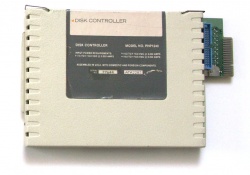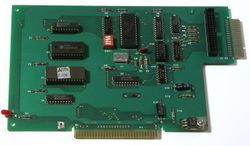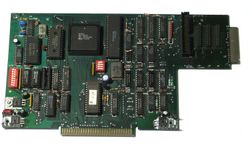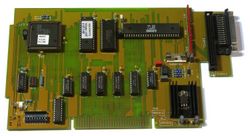Difference between revisions of "Floppy Disk and Hard Disk Controller Cards"
Stephen Shaw (talk | contribs) m (added link to cassette article) |
Stephen Shaw (talk | contribs) m (add internal links TI Basic and ExBas) |
||
| Line 1: | Line 1: | ||
Texas Instruments designed the peripheral expansion system to utilize industry hardware, so it was merely necessary to provide a disk controller card while the disk drive could be selected from a broad selection of third-party drives. | Texas Instruments designed the peripheral expansion system to utilize industry hardware, so it was merely necessary to provide a disk controller card while the disk drive could be selected from a broad selection of third-party drives. | ||
The disk controller was arguably the first expansion card of every user, since it allowed to switch from [[cassette]] file handling to the much more comfortable disk system. Moreover, TI BASIC and Extended | The disk controller was arguably the first expansion card of every user, since it allowed to switch from [[cassette]] file handling to the much more comfortable disk system. Moreover, [[TI BASIC]] and [[Extended BASIC]] are well prepared for disk usage, so this was a wise investment. | ||
Some cartridges like Editor/Assembler not only required a memory expansion but also a disk drive since the Editor and the Assembler were only available on disk, | Some cartridges like Editor/Assembler not only required a memory expansion but also a disk drive since the Editor and the Assembler were only available on disk, | ||
Revision as of 19:48, 16 September 2014
Texas Instruments designed the peripheral expansion system to utilize industry hardware, so it was merely necessary to provide a disk controller card while the disk drive could be selected from a broad selection of third-party drives.
The disk controller was arguably the first expansion card of every user, since it allowed to switch from cassette file handling to the much more comfortable disk system. Moreover, TI BASIC and Extended BASIC are well prepared for disk usage, so this was a wise investment.
Some cartridges like Editor/Assembler not only required a memory expansion but also a disk drive since the Editor and the Assembler were only available on disk,
Single-Density Floppy Disk Controller Card
The original floppy disk controller from TI allows to attach up to three double-sided floppy disk drives.
The controller card is based on the FD1771 Floppy Disk Controller chip, the first chip from the WD17xx family of Western Digital. This chip is capable of controlling 40-track drives with FM recording (single density), single- or double-sided, so we get 90 KiB storage space on SSSD (single-sided, single density) and 180 KiB on DSSD disks.
Later third-party modifications allow use of 80-track disk drives, which increase total possible storage to 360K per disk.
Double-Density Floppy Disk Controller Card
The TI Double-Density Floppy Disk Controller Card was released as a build-it-yourself kit to the members of the engineering department at Dallas (and possibly at other locations). It was never sold commercially. The card was designed to use a 765 floppy controller chip. Almost all known examples exhibit stability problems due to overheating of the voltage regulator chip unless a high-quality heat sink is installed (this was not included in the original design or the parts kit). Between 10 and 30 examples of this card are known to exist within the TI community.
This card allowed several different formatting options using the Disk Manager 3 cartridge. It had two Single-Density and two Double-Density formatting modes.
It would format in Single-Sided, Single-Density (SSSD) by dividing one side of the disk into 40 tracks of 9 sectors each, for a total of 90K per disk. This system could be extended to be used to format Double-Sided, Single-Density (DSSD) disks. The disks would then have 40 tracks of 9 sectors each on each side of the disk, for a total of 180K per disk. Data was written to the disk using the FM method to separate data and timing signals, placing the timing data between the data sectors.
It would also format in Single-Sided, Double-Density (SSDD) mode. This followed the Texas Instruments specifications for Double-Density, a standard that was ignored for all third-party controllers except the ones from Myarc. The disk was again divided into 40 tracks, but now it had 16 sectors per track, for a total of 160K. Once again, the controller could extend this scheme to use it with a Double-Sided, Double-Density (DSDD) disk. Each side of the disk has 40 tracks of 16 sectors for a total of 320K. Disks formatted in either of the 16-sector double-density formats can not be read by CorComp, Atronic, or BwG double-density disk controller cards, but can be read by the Myarc controllers or when using any manufacturer's DSDD controller with a Geneve 9640.
Atronic Double-Density Floppy Disk Controller
This card came with a disk manager program on disk, which it would auto-load during the boot process if it was in DSK1. The disk manager was in Assembly and required a 32K Memory Expansion to be present to load. Many programs testing for Floppy Disk Controllers will misidentify this one as a CorComp product. The two cards use the same Disk Controller chip. Between 50 and 100 examples of this card were sold.
CorComp Double-Density Floppy Disk Controller
This card was one of the most popular third-party expansion cards for the TI-99/4A. Several different revisions are known. The earliest examples have a WD2793 disk controller chip, but most of them were built around the WD1773 disk controller chip. The earliest cards came in a gray aluminum shell, which soon gave way to the most common version with a black aluminum shell. The later versions eliminated the shell completely as a cost-cutting measure.
Myarc Personality Card
This was the first hard disk controller for the TI-99/4A. The Personality Card allowed the computer to interface with external SASI hard disks, of between 5 and 15 Megabytes. Most systems were sold with 10 Megabyte disk drives. Very few examples of this card were sold, as the list price for one of the 10 Megabyte systems was in the vicinity of $2,500. It was possible to set the card at different CRU addresses and put multiple examples into a single PEB. This was rarely done.
Myarc Double-Density Controller Card
Myarc's Double-Density Controller Card (DDCC) features a WD1770 controller chip. In contrast to the lowered package number compared to the WD1771, this chip contains an internal data separator and write precompensator, and allows for using double density (see also the descriptions on WD1771 in Wikipedia). Unlike the much more complex HFDC, the DDCC is a comparably robust disk controller which works flawlessly with 5,25" and 3,5" drives with up to 80 tracks and MFM recording. Thus, this controller handles disks with up to 720 KiB. The most frequently used format was DSDD40.
Myarc Hard and Floppy Disk Controller
The Myarc HFDC was one of the most sophisticated controllers built for the TI computer family. It allows to control up to three floppy disk drives and up to three MFM hard disk drives; moreover, the controller was prepared to control one tape drive.
Some versions of the HFDC shipped as "HDCC-1 Winchester Card / Hard Disk Controller Card with Floppy Disk Option". The picture shows the PCB of such a controller.
The controller makes use of the HDC9234 controller from the SMC92x4 controller family. It is capable of handling disks with 40 to 80 tracks and single or double density, for a maximum of 720 KiB. Actually, it was planned to handle even higher densities (reaching 1.44 MiB per disk), but the controller software is flawed, and the data separator cannot cope with the data rate either. Due to the common usage of 40-track drives, the most frequently used format was DSDD40, i.e. 360 KiB.
The HFDC was known to show some reliability issues with floppy disks, so in some cases people used the controller just to access the hard drives, next to another floppy disk controller like the Myarc DDCC.
Use of 1.44MB (high density) disks is possible and reliable, under three conditions:
- The data separator is the 9216B version, not the commonly installed 9216 version. Some 9216s are capable of the faster transfer rate but are not rated for it.
- The memory must be upgraded from 8k to 32k
- The card must be used with a Geneve.
While the manual states that there is a capability of handling tape drives, there is no known application of a tape drive for this controller.
Nouspikel IDE Interface
TODO
Nouspikel Smart Media/USB Interface
TODO
SNUG ASCSI Card
The ASCSI card was build by the System Ninety-Niner Users Group around 1997. It was based on the WHTech SCSI card, however, substantially improved with a MACH circuit and with a revised DSR. This rebuild was also a reaction on delivery delays of the WHTech card to Europe.
The card proved to be very reliable, useable with the TI or the Geneve, and very fast due to its improved DMA performance. It is based on the SCSI controller chip 53C80.
Credits for this card go to
- Michael Becker (SNUG, hardware design, PLD development, documentation)
- Jürgen Stelter (TIW, PCB design, component procurement)
- Götz Feuerstein (Beta tester)
- Wolfgang Betzl (TI-Club Berlin)
SNUG BwG DSDD Disk Controller Card
This was the first major hobbyist-designed card built for the German market, and was developed as a response to the collapse of Atronic as a local source for Double-Density floppy disk controllers. Both CorComp and Myarc cards were still available at the time, but they were difficult to acquire in Europe. The card and its DSR were designed by three very talented individuals: Michael Becker (hardware), Christopher Winter (software), and Harald Glaab (Software). The majority of the work was done by Michael Becker and Harald Glaab, as Christopher Winter was in the process of abandoning TI development at the time the card was designed. Over 105 of these cards were sold, mostly in Europe, although a few of them were sold to US customers. It is one of the most stable floppy disk controllers available for the TI. It uses the WD1773 FDC chip, with lack of sources for additional WD1773 chips at affordable prices being the prime reason that production of additional units ceased. Most of the european cards are sold to the big TI-community of Switzerland, but nobody knows where these cards are left when the swiss TI-community disappeared...
Western Horizon Technologies (WHTech) SCSI Controller
TODO



